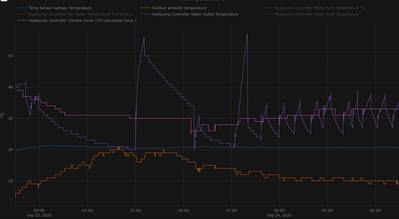Posted by: @bensonRegarding the warm end of the WC curve, are there any particular parameters that people would recommend?
The real answer is trial and error, because there are a lot of variables, and no two houses will be exactly the same. A good starting point for an average property with radiators might be 30 @ 15 for the right hand warmer OAT end of the curve, and then the design parameters at the left hand cooler OAT end of the curve, eg 45 @ -2, but this will vary eg given the space constraints I have radiators that are on the small side, and so I need a higher LWT at the lower end of the curve, currently 52 @ -2, which is down a bit from the design parameters of 55 @ -2. The right hand end of my curve is currently 31 @ 15. It is also worth bearing in mind that outside the OAT endpoints, the 'curve' flat lines, ie 31 @ 15 is really 31 @ 12 and above degrees, and 52 @ -2 is really 52 @ -2 and below degrees.
Posted by: @bensonFurthermore I guess this is the time of year when the heating might just need to be turned on and off when a bit cold as it isn't quite 'full' heating season yet...
Mostly for historical reasons, ie habit, I try to have one day, preferably in October, when the heating goes on and stays on. But with a heat pump, there really is nothing to stop you putting it on a bit earlier if it is nippy and turning it off again if things warm up. My kitchen room temp this morning when I got up was 15 degrees, if it gets much lower I shall say weather be damned, and the heating will go on!
Midea 14kW (for now...) ASHP heating both building and DHW
Posted by: @papahuhuIf it helps, my outlet is running at 25C.
It would seem to be erroneous that someone set a minimum flow temperature in the controller if you were using the homely, that is going to limit it’s low end (most efficient) range for no good reason. The high end range mayb necessary, but only if you have heat sensitive emitters, ie UFH.
Interesting to know- is that with UFH? Another slight frustration with homely was that it wouldn't let you alter the max and min flow temps and that it was all set up by the installer upon commissioning.
Thanks all.
Generally at the moment the heating is coming on a bit in the early hours of the morning. I've set up a couple of automations for it to come on if the temp drops below 20, and turn off when it reaches 21. This is generally keeping things steady but very much on and off. Wife would definitely not appreciate the kitchen at 15 degrees C!
I thought if I set the flow temp min value too low the ASHP may struggle to cope with this and start excessively cycling (we are all radiators). Useful to have a few benchmarks of what others are using but will have a look at experimenting with the settings a bit more.
I don’t have UFH. It’s been running at 25C even when the outside temp is 4 or 5 C at night the last few days when there’s been no cloud cover.
There is technical guidance from homely to specifically avoid setting the minimum flow temp too high in the heat pump controller, because that parameter overrides the homely algorithm to manage the economic functioning of the unit.
As far as I understanding the machine learning functionality, it uses both the outside temp (from a weather station as opposed to the outside thermocouple) and the internal node reading to jiggle the unit inputs to match an economical output. It takes about20 days of jiggling about to learn the optimum control settings.
There are technical instructions in the installer resources to step by step set the controller for each brand. The main thing is to disable weather comp and to set appropriate minimum and max flow temp. They also have to set the DHW parameters in full as the homely only acts as a schedule tool for that.
it’s not perfect, for example it doesn’t let me setback the nighttime temp (rather, I can set it but it ignores it!) I’m told it can be done on a smart+ subscription, but I refuse to pay £25 as I’m a tight wad. However that’s my only gripe, so far. My heating is on 24 hours a day and it’s a big house at 300m2 and a big heat pump at 16kW, it’s using 8kwh of power over the 24 hrs with a COP of 5.2 at the moment and the temp hasnt dropped below the set point once. Absolutely amazing from my perspective.
I humbly suggest to get someone whom knows what they are doing to start from scratch and set it up for you before the heating season starts in full. If it helps I found Conor Murphy from Plug-me-in to be superb, they are based just north of Salford ( where Homely is HQ’d) and I know there is considerable interaction betweenboth. I think Plug-me-in operates nationally, although it is a smallish business. We are in the Peak District but I’m sure the fitters told me they were on the south coast the following week.
Posted by: @bensonI've set up a couple of automations for it to come on if the temp drops below 20, and turn off when it reaches 21. This is generally keeping things steady but very much on and off.
It seems to me that running it like this is, in effect, running it on a thermostat with the automations doing what a thermostat would do, and the inevitable stop/start running, ie classic fossil fuel running. Have you also got weather compensation on at the moment? I presume not. If so (no WCC, just room stat by HA automation), it would be very interesting to see a chart with the usual parameters (OAT, IAT, set and actual LWT, RWT, and if you can add them flow rate and compressor speed) over several hours (12-14) when the OAT is relatively mild. I think it might be very interesting to compare WCC cycling with room stat cycling.
Midea 14kW (for now...) ASHP heating both building and DHW
Posted by: @papahuhuI humbly suggest to get someone whom knows what they are doing to start from scratch and set it up for you before the heating season starts in full. If it helps I found Conor Murphy from Plug-me-in to be superb, they are based just north of Salford ( where Homely is HQ’d) and I know there is considerable interaction betweenboth. I think Plug-me-in operates nationally, although it is a smallish business. We are in the Peak District but I’m sure the fitters told me they were on the south coast the following week.
I don't need to get an installer in to set my WC curve. It is basic stuff now that I have the svenar/HA dashboard set up and I can keep my home warm no problem and in any case it would be very much a process of changing parameters and seeing what works best over a period of time rather than an engineer visit. Homely is certainly a complete short cut to all of that effort but this whole thread is based on scratching the itch and establishing whether pure weather comp (for sure I have some tweaking to do before that is perfected) works better than the algorithms of homely.
I appreciate I have deviated a little from these principles with respect to the automations but it seems that this weather is that specific period whereby with the best will in the world, heating is going to be required a little on/off. Generally the house is kept warm enough during the day via milder outdoor temps and solar gain. I appreciate a lot of people grin and bear it with respect to it being chilly first thing in the morning but that isn't for us. Homely acted no differently for us in this regard and was very much on/off certainly in the autumn and spring, from reviewing the data on the dashboard. What I don't get it why the installers set the min flow temp as 35 and I assume this was to prevent excessive cycling perhaps, or maybe this was another odd decision on their part that was of no benefit to us.
@cathoderay yes I most definitely have WC on. What I am struggling with at the moment is having a low enough flow temp to keep it coasting along in this milder weather as a curve set at 31 LWT at 15 OAT and 47 at -2 (I know this end is more or less correct) results in the house being too warm.
@benson
Don’t let a poor installer off the hook even if it’s an ECO4 install that’s free of charge or if they have stopped trading. If it’s an MCS install, contact MCS via the complaint procedure, they will put you in contact with the professional body that oversees that particular installer whom will initiate an investigation and if needed, audit the install. I had to do this with an uncooperative PV installer, once they knew I was poised to go this route everything changed and they implemented acceptable remedies, fully at their cost (they had to install new scaffolding) in addition to replacement units that they had been standing on.
Consumers have protections under law, they are there to be used.
@papahuhu I appreciate well intentioned but we are going off on a tangent here. It's not about letting anyone off the hook and I can assure you that our installers have paid for their errors and omissions in the delivery of our ASHP commissioning, our rather we have been adequately compensated I believe. This is my decision to take back control of my heating system as I felt that homely was generally good, but flawed. I'd also consider myself as generally competent and with the knowledge of this forum I have learnt a lot, and continue to do so...and I'd also consider the collective knowledge of this forum to be superior to most installers to be honest.
Posted by: @papahuhuI don’t have UFH. It’s been running at 25C even when the outside temp is 4 or 5 C at night the last few days when there’s been no cloud cover.
I think statements of this kind should be considered in the right context, because it may mislead people into thinking that there is something terribly wrong with their system. Warming a big house (at what IAT ?) with 25C leaving temperature at 4C OAT, seems to me a miracle unless the house is very well insulated and has a large radiator capacitance. Therefore, I would like to see this information along perhaps with a 24-hour graph of all relevant parameters, if possible.
If something is physically unrealizable, there is no algorithm in the world to realize it.
Midea MHCV10WD2N7 R290, 5.8kWp energy community solar power.
Think I may be getting somewhere. The lowest permissable outlet flow temp on the Clivet unit is 25, so I have dialled this down to 26 at 15 OAT.
Close up of IAT, so I changed the parameters at around 2000hrs, and it's been much more steady with less peaks and troughs.
Wonder what the perceived benefits were of setting the min flow temp on homely to 35 degrees C....?
Posted by: @tasosThere is something terribly wrong with the control of LWT. Where do the peaks come from?
It looks to me like its cycling and the peaks are 'normal' (for cycling) overshoot because the heat pump cant modulate down far enough to match the load from the house. unfortunately no electricity consumption plot to be certain.
4kW peak of solar PV since 2011; EV and a 1930s house which has been partially renovated to improve its efficiency. 7kW Vaillant heat pump.
- 26 Forums
- 2,338 Topics
- 52.8 K Posts
- 179 Online
- 5,994 Members
Join Us!
Podcast Picks
Latest Posts
-
RE: Grant Aerona Short Cycling
@grantmethestrength that looks interesting, can you sha...
By damonc , 2 minutes ago
-
RE: What a Bad Heat Pump Installation Looks Like
I am curious about what was MCS' role in this process? ...
By Batpred , 7 hours ago
-
RE: Aira Heat Pump: Stylish Scandinavian Heating
Has anyone tried using the Smart Tariff Control on the ...
By ChandyKris , 10 hours ago
-
RE: Experience with Mitsu Par 50/60 Wireless Controller
The 27°C request doesn't boost the weather compensation...
By Sheriff Fatman , 14 hours ago
-
RE: Getting the best out of a heat pump - is Homely a possible answer?
Oh and it was installed by Stevie Wonder!
By Grantmethestrength , 16 hours ago
-
There seems to be plenty of evidence to support this. ...
By JamesPa , 23 hours ago
-
RE: One Year Review: Grant 13kW ASHP - A Catalogue of Errors
@solenoid it sounds like you are making progress. No n...
By JamesPa , 24 hours ago
-

RE: LiFePO4 lithium battery fires and explosions
@iaack — thanks, a useful video. They do make it clear...
By cathodeRay , 1 day ago
-
RE: How good is the app support for your heat pump?
I think you are right about the ebus stick. It's cert...
By JamesPa , 2 days ago
-

RE: My DIY Heat Pump installation
@majordennisbloodnok Element-ary my Dear Major.
By Toodles , 2 days ago
-
RE: Replacing my 18 month old Hitachi Yutaki ASHP
Yes, you can work out a lot from a plot of FT. Interes...
By JamesPa , 2 days ago
-

Welcome to the forums @isaac. What you’re describing is...
By Mars , 2 days ago
-

Win an Eve Smart Home Bundle worth over £350!
Win an Eve Smart Home Bundle worth over £350! ...
By Mars , 2 days ago
-
RE: Is your heat pump insured?
I chose Tesco in the end. Unambiguously cover HP, PV an...
By Davesoa , 2 days ago
-
RE: Help me keep the faith with my air source heat pump installation
@adamk You can get an idea of if your flow and return...
By SimonF , 2 days ago
-
This Solis inverter being rated 8kw and (I expect, as I...
By Batpred , 2 days ago
-
RE: A2A vs A2W: Which Heat Pump Would You Pick?
I have one fancoil in an otherwise all radiator system....
By JamesPa , 2 days ago
-

RE: Electricity price predictions
That's understandable...but I was referring to our 'oth...
By Transparent , 3 days ago







